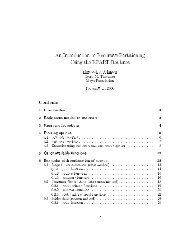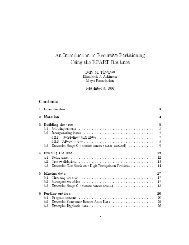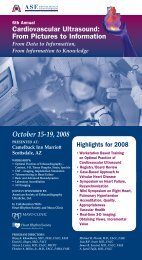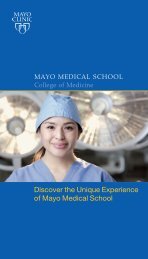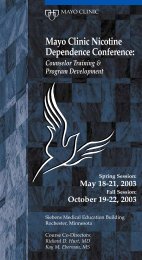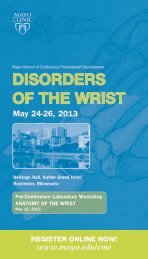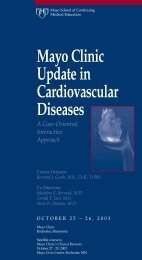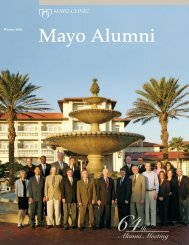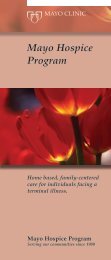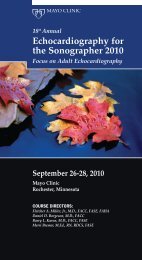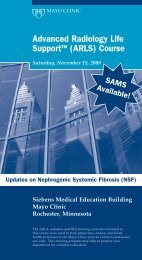current issue - Mayo Clinic
current issue - Mayo Clinic
current issue - Mayo Clinic
Create successful ePaper yourself
Turn your PDF publications into a flip-book with our unique Google optimized e-Paper software.
Where<br />
are they?<br />
now<br />
“<strong>Mayo</strong> <strong>Clinic</strong> provided me with a great opportunity to<br />
initiate my academic career and learn about methodology<br />
and starting a research program,” says Dr. Azpiroz. “My<br />
work at <strong>Mayo</strong> became the base of my research program and<br />
my foray into publications with an international reputation.<br />
I’m grateful to <strong>Mayo</strong> and the Kendall Award for the very<br />
satisfying role they played in fulfilling my aspirations.”<br />
“Glorious” is how Dr. Azpiroz describes the<br />
GI program at <strong>Mayo</strong> <strong>Clinic</strong> at that time. ”Most<br />
of the leaders in the field today trained at<br />
<strong>Mayo</strong>, including the 20 fellows that I<br />
trained with,” he says. “I loved being<br />
there. The extraordinary advice and<br />
facilities allowed us to work very hard<br />
and accomplish a great deal. I’m<br />
grateful for the lifelong connections<br />
with other scientists I made at <strong>Mayo</strong><br />
<strong>Clinic</strong> in the divisions of Gastro–<br />
enterology and Hepatology, and<br />
Gastroenterologic and General Surgery.”<br />
Back in Spain, focusing on the gut<br />
After his fellowship, Dr. Azpiroz went to Vall<br />
d’Hebron University Hospital at the<br />
Autonomous University of Barcelona, Spain.<br />
He remains there as professor of medicine and<br />
chief of the Department of Gastroenterology.<br />
His clinical practice focuses on functional gut disorders. His<br />
research program investigates the origin of gastrointestinal<br />
symptoms and involves physiologic and pathophysiologic<br />
aspects about the control mechanisms of gut motility, visceral<br />
sensitivity, intestinal gas and abdominal bloating.<br />
Michael Camilleri, M.D. (GI ’84, GI ’88), a consultant in<br />
the Division of Gastroenterology and Hepatology at <strong>Mayo</strong><br />
<strong>Clinic</strong> in Rochester, trained with Dr. Azprioz. “His research<br />
at <strong>Mayo</strong> <strong>Clinic</strong> led to important new directions that he<br />
continued to pursue for two decades after he returned<br />
to Spain,” says Dr. Camilleri. “He has worked on the<br />
understanding of the common symptoms of abdominal<br />
bloating and pain and, more recently, has teamed with<br />
scientists who investigate the human gastrointestinal<br />
microbiome.”<br />
Well-known leader moving the field forward<br />
Dr. Azpiroz is a councilor of United European<br />
Gastroenterology, and he recently completed<br />
10-year terms as associate editor of the<br />
American Journal of Gastroenterology and<br />
president of the European Society for<br />
Neurogastroenterology and Motility.<br />
He has published 104 original articles<br />
and 57 book chapters, and has been an<br />
invited lecturer more than 230 times.<br />
Gianrico Farrugia, M.D. (I ’91,<br />
GI ’94), a consultant in the Division<br />
of Gastroenterology and Hepatology<br />
at <strong>Mayo</strong> <strong>Clinic</strong> in Rochester, says<br />
Dr. Azpiroz’s name is instantly<br />
recognizable among European medical<br />
professionals. “He established himself as<br />
one of the leaders in GI motility, invented<br />
Fernando Azpiroz, M.D., Ph.D. technologies to measure how gas moves<br />
through the GI tract, and brought attention<br />
to the role of bacteria in the gut — how it keeps<br />
us healthy and how it makes us sick,” says Dr. Farrugia.<br />
“Dr. Azpiroz is an energetic innovator who is not satisfied<br />
with the status quo,” says Dr. Farrugia. “A demonstration of<br />
this is his influence and effectiveness as an administrator.<br />
He, Dr. Camilleri and others joined forces to bring together<br />
the European and American Neurogastroenterology and<br />
Motility societies in a federation with joint international<br />
meetings that attract more than 1,000 scientists and physicians.<br />
This convening of talent and knowledge helps to move the<br />
field forward.”<br />
??<br />
?<br />
2013 | No. 1 17



